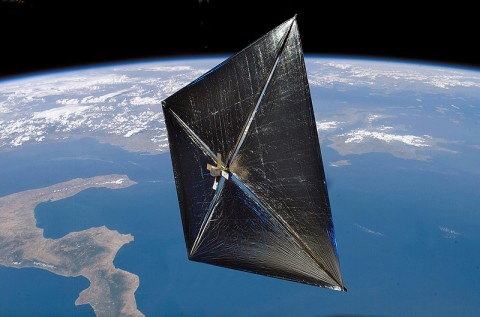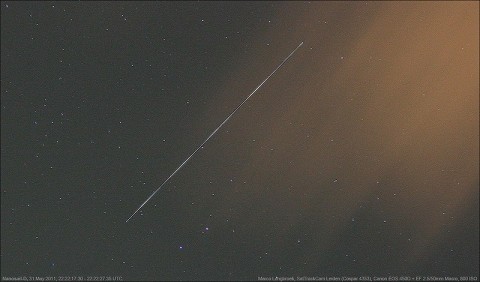Written by Janet L. Anderson
Marshall Space Flight Center
 Huntsville, AL – After spending more than 240 days “sailing” around the Earth, NASA’s NanoSail-D — a nanosatellite that deployed NASA’s first-ever solar sail in low-Earth orbit — has successfully completed its Earth orbiting mission.
Huntsville, AL – After spending more than 240 days “sailing” around the Earth, NASA’s NanoSail-D — a nanosatellite that deployed NASA’s first-ever solar sail in low-Earth orbit — has successfully completed its Earth orbiting mission.
Launched to space November 19th, 2010 as a payload on NASA’s FASTSAT, a small satellite, NanoSail-D’s sail deployed on January 20th.
The flight phase of the mission successfully demonstrated a deorbit capability that could potentially be used to bring down decommissioned satellites and space debris by re-entering and totally burning up in the Earth’s atmosphere. The team continues to analyze the orbital data to determine how future satellites can use this new technology.

“The NanoSail-D mission produced a wealth of data that will be useful in understanding how these types of passive deorbit devices react to the upper atmosphere,” said Joe Casas, FASTSAT project scientist at NASA’s Marshall Space Flight Center in Huntsville, AL.
“The data collected from the mission is being evaluated, said Casas, in conjunction with data from FASTSAT science experiments intended to study and better understand the drag influences of Earth’s upper atmosphere on satellite orbital re-entry.”
The FASTSAT science experiments are led by NASA’s Goddard Space Flight Center in Greenbelt, MD and sponsored by the Department of Defense Space Experiments Review Board which is supported by the Department of Defense Space Test Program.
Initial assessment indicates NanoSail-D exhibited the predicted cyclical deorbit rate behavior that was only previously theorized by researchers.

“The final rate of descent depended on the nature of solar activity, the density of the atmosphere surrounding NanoSail-D and the angle of the sail to the orbital track,” said Dean Alhorn, principal investigator for NanoSail-D at Marshall Space Flight Center. “It is astounding to see how the satellite reacted to the sun’s solar pressure. The recent solar flares increased the drag and brought the nanosatellite back home quickly.”
NanoSail-D orbited the Earth for 240 days performing well beyond expectations and burned up during reentry to Earth’s atmosphere on September 17th.
NASA formed a partnership with Spaceweather.com to engage the amateur astronomy community to submit images of the orbiting NanoSail-D solar sail during the flight phase of the mission. NanoSail-D was a very elusive target to spot in the night sky — at times very bright and other times difficult to see at all. Many ground observations were made over the course of the mission. The imaging challenge concluded with NanoSail-D’s deorbit. Winners will be announced in early 2012.
For more information, visit: www.nanosail.org
The NanoSail-D experiment was managed at the Marshall Center, and designed and built by engineers in Huntsville. Additional design, testing, integration and execution of key spacecraft bus development and deployment support operation activities were conducted by engineers at NASA’s Ames Research Center in Moffett Field, CA. The experiment is the result of a collaborative partnership between NASA; the Department of Defense Space Test Program, and the U.S. Army Space and Missile Defense Command, the Von Braun Center for Science and Innovation, Dynetics Inc. and Mantech Nexolve Corp.
For more information about NanoSail-D visit:
www.nasa.gov/mission_pages/smallsats/nanosaild.html


